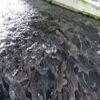Two main processes lead to the formation of soil (loosed and unconsolidated) from rocks (hard and consolidated). The first is the physical aspect which does not involve chemical change.
That is, if we start with homogenous parent material, we have homogenous soil. The second is the chemical aspect which involves chemical changes. These two processes occur simultaneously.
Read More: The Definition and Classifications of Cropping System
1. Physical Weathering
Physical weathering ensures that rocks are broken down into smaller particle sizes. The processes in physical weathering include freezing and thawing, uneven heating, abrasion, shrinking, and swelling which break large particles into smaller ones.
In cold climates like Canada, water collected in crevices expands during freezing; this makes the rock crack. The roots of plants generate some pressure and cause rocks to break into pieces. Water and wind moving some materials cause them to scour.
2. Chemical Weathering
Chemical weathering is the main process of converting parent material into the soil while the bulk of chemical weathering is brought about by water.
Organic and inorganic acids contained in water enhance mineral weathering.
Chemical weathering may take the forms stated below:
Read Also: Composition of Soils and Soil Materials
Hydrolysis
This is the chemical alteration of a mineral and the formation of its oxide through the action of water.
In the presence of CO2, K2 CO3 will be formed instead of KOH in the equation. That is, the process of hydrolysis usually results in the formation of compounds different from the parent material.
Solution
The solvent action of the water can dissolve soluble materials or rocks due to the nature of the acidic property it has.
Read Also: The 5 Physical Soil Factors Affecting Crop Production
3. Hydration
In this case, water molecules are being added to a mineral’s structure but the water molecule does not dissociate. Significantly, the rock swells when water molecules get inside it making it very susceptible to the activity of other weathering processes.
For example, Hematite, hydrates and dehydrates readily when water enters and leaves its interlayer. These minerals give rise to the red, brown, and yellow color of soils.
4. Oxidation Reduction
Oxidation-reduction reactions are very important in minerals that have Fe2+ such as biotite mica. Depending on the environment, various compounds can be formed in oxidative processes.
For instance, the oxidation of Fe2+ to Fe3+ will strain the crystal and results in further weathering of the mineral. The formation of mottles is a result of the reduction of iron (Fe) and manganese (CO2) in soil.
Read Also: Concept of Soil Morphology
5. Carbonation
Carbon dioxide (CO2) may combine with water to dissolve marble, or it may combine with other compounds to form carbonate precipitates.





